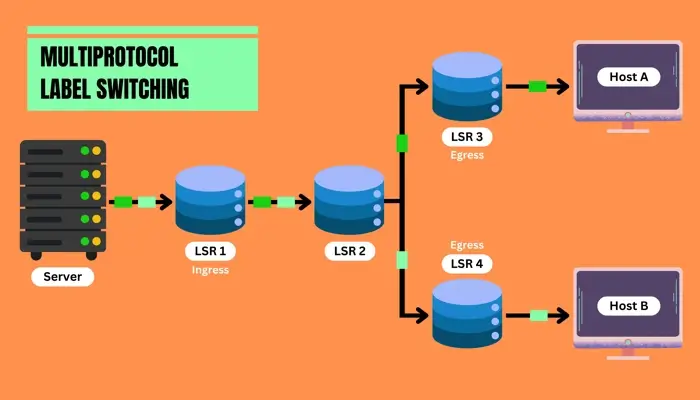What Is Multiprotocol Label Switching (MPLS)?
A key function of the Internet is data transfer, which is pivotal for connecting the global network of computers. Traditionally, data moving across networks relied on the IP routing protocol. However, Multiprotocol Label Switching (MPLS) technology was introduced to optimally route data across networks.
Today we’re going to look at what exactly MPLS is, how it works, its benefits and a lot more.
What is Multiprotocol Label Switching?
Multiprotocol Label Switching by definition is a network routing method that routes data from one network node to the next based on short path labels rather than network addresses. These labels usually correspond to IP destination networks.
The Multiprotocol Label Switching (MPLS) technique was designed as an alternative to traditional IP (Internal Protocol) routing. Essentially, an IP packet travels over the Internet hop-by-hop. As the packet reaches its destination, many routers help forward it along the way.
In a two-router interaction, Router A opens the packet and reads the IP address. It then forwards the packet to the next router based on its routing protocols. Every other router repeats the same process until the packet arrives at its destination.
As with IP packet routing or switching, the data path is not fixed. Each router on the network path makes individual decisions about where to send each packet. MPLS addresses the issue of slow data transfer.
Origins of Multiprotocol Label Switching
MPLS originated in the 1990s as a game-changer for enterprise wide area networks. It started as a proprietary protocol and later became standardized by the Internet Engineering Task Force (IETF). The mechanism intends to speed up and shape how traffic flows across networks.
MPLS connections send packets along a predetermined network path using labels. Each label is like a GPS waypoint, ensuring packets stay on track and reach their destination faster. The packet follows the same route every time.
MPLS is favorable for high-speed telecommunication networks. The "multiprotocol" aspect means it can carry various types of network traffic, including IP packets, Ethernet frames, and even ATM (Asynchronous Transport Mode) cells.

How does MPLS work?
Anything sent over the Internet is broken down into smaller packets. Each packet may go through multiple hops before it reaches the intended recipient.
This IP-based routing is ideal for most Internet traffic purposes. However, some organizations seek faster data transmission and greater control over the paths their data travels. MPLS assigns labels to packets to determine the shortest route for packet forwarding over a network.
MPLS addresses incoming packets to their destination based on the content written on their labels. When a data packet enters an MPLS network, it is assigned to a specific forwarding Class of Service (CoS) called a Forwarding Equivalence Class (FEC). This classification helps the network decide how to handle the packet as it travels through the network.
Next, the ingress router, a Label Edge Router (LER), assigns a special label to the packet. This label contains essential information that will dictate the path the packet should take. These predefined routes, called Label-Switched Paths (LSPs), are created to optimize traffic flow. Packets that belong to the same FEC will travel along the same LSP.
As the packet moves through the network, it encounters various routers called Label Switch Routers (LSRs). Each LSR uses the packet’s label to make quick forwarding decisions, eliminating the need for complex IP lookups. The router checks its label forwarding table to find the next hop along the LSP, swaps the label with a new one, and sends the packet.
Labels are inserted between the packet's Layer 2 and Layer 3 headers. The final step occurs when the packet reaches the egress router, which is the last router in the MPLS network. This router removes the MPLS label, and the packet is then forwarded to its destination using traditional IP routing.
Rules for MPLS
Routers in an MPLS network must follow a series of rules to make data packets get across the MPLS domain.
- Assign labels. When a router receives a packet, it assigns an MPLS 32-bit label to the packet header. This label guides the packet’s journey through a predefined route and is based on criteria, such as the destination IP address.
- Share labels. Routers must share labels with their neighboring routers. This process is accomplished using Label Distribution Protocols (LDP). When routers exchange labels, they communicate their assigned labels for specific paths so that every router in the network understands which label corresponds to which forwarding path.
- Build forwarding tables. Each router in the MPLS network maintains a label-forwarding information base (LFIB). This table maps incoming labels to outgoing labels and interfaces.
- Forward using labels. Routers forward packets based solely on their labels without inspecting the packet's IP header. When a labeled packet reaches a router, the router swaps the incoming label with the appropriate outgoing label found in the LFIB and forwards the packet to the next router in the label-switched path.
MPLS also allows for label stacking, meaning multiple labels can be attached to a single packet. This feature supports more complex routing management, like tunneling through different network segments.
Components of Multiprotocol Label Switching
MPLS uses labels to direct data transfer across a network reliably. The routing technology leverages characteristics of both Layer 2 and Layer 3 of the OSI model. Because it almost exists between the two layers, many refer to it as the Layer 2.5 protocol.
While network addresses identify endpoints themselves, labels identify established paths between desired endpoints. The four key components of an MPLS label that enable its functionality include:
- Label value. The label value is a short, unique identifier assigned to each connection and used to make forwarding decisions within the MPLS network. Labels are preferred instead of complex IP lookups at a routing table at every stop, allowing for faster data transfer.
- Traffic class (TC). The traffic class is a 3-bit field called the "Class of Service" (CoS) bits. It works for quality of service (QoS) purposes, which defines the packet's priority in terms of forwarding. It helps traffic management by determining the packet processing order and handling during network congestion.
- Bottom of stack (S). This is a one-bit flag that indicates if the label is at the bottom of the label stack. MPLS supports label stacking, allowing multiple labels to integrate into more complex routing decisions. If this bit is set to 1, the label is the last in the stack, signifying that the packet should be processed based on the protocol information in the payload.
- Time to live (TTL). Time to live is an 8-bit field indicating the maximum number of hops the packet can traverse before being discarded. It helps prevent packets from endlessly looping in the network due to routing errors. Each time the packet passes through an MPLS router, the TTL value decreases by one. If the TTL values reach zero, the process discards the packet.
Benefits of using MPLS
Most users consider Multiprotocol Label Switching to be a more established technology that offers benefits over traditional IP routing. However, it faces competition from more adaptable solutions like SD-WAN and SASE. Despite this, MPLS still has several advantages.
- Traffic engineering capabilities. The network enables precise control over data paths using Label-Switched Paths (LSPs). Network administrators can direct traffic along specific routes to avoid congestion and optimize bandwidth usage.
- Improved network scalability. MPLS networks can handle growing amounts of traffic. By using labels for routing, MPLS supplements IP routing for data forwarding.
- Simplified network management. Label-based routing unifies the management of different traffic types, like IP or Ethernet, under a single protocol. Instead of relying on complex routing tables, labels guide routing decisions and reduce configuration complexity.
- Agnostic protocol support. The multiprotocol support feature of MPLS makes it an adaptable technology. It suggests that MPLS lacks ties to any specific protocol or transport medium. Generalized MPLS (GMPLS) extends the capabilities of MPLS to include other switching technologies beyond packet switching, such as time-division multiplexing.
- Reduced latency and improved performance. The MPLS uses shorter path labels to route data at a faster rate. Therefore, it has become beneficial for latency-sensitive applications that require rapid data transmission, like video and voice calls. For performance, MPLS can prioritize different types of data, and organizations can assign different bandwidth percentages to various kinds of data.
- Increased security features. The routing method isolates traffic through distinct LSPs and prevents data from mixing with other traffic streams. This isolation adds a layer of security, as packets are not easily accessible outside their assigned paths.
Applications of MPLS in modern networks
Multiprotocol Label Switching has had a continuing role in our data networks for decades now. It has brought efficiency, reliability, and scalable routing out of many things. The impact of MPLS can be seen in its many applications, from virtual private networks to multiservice networks.
Multiservice networks
In recent years, IP Multiprotocol Label Switching has replaced many network protocols. This is because MPLS is a multiservice network technology and can deliver the same level of performance, even for the most critical applications like voice calls and video streaming, all at the same time.
It consolidates multiple different types of services over a single network infrastructure. Even specialized mobile networks have moved to using MPLS since 4G/LTE.
Virtual private networks (VPNs)
MPLS supports the creation of Layer 3 VPNs, allowing large enterprises to interconnect multiple locations securely over a shared MPLS backbone. They include corporations with offices spread over a vast land mass, industries located in more than one country, and more.
Quality of Service (QoS)
A typical MPLS network supports Quality of Service (QOS) to differentiate traffic types. Labels include traffic class information that helps prioritize different network traffic types.
For example, real-time applications like VoIP and video conferencing can receive higher priority over less sensitive data.
Metro Ethernet services
MPLS provides a flexible platform for delivering Metro Ethernet services. Layer 2 point-to-point is suitable for businesses looking for high bandwidth connections connecting multiple sites within a metropolitan area while maintaining cost-effectiveness.
MPLS vs. SD-WAN vs. SASE
The advent of Multiprotocol Label Switching phased out old traffic routing methods. However, most companies don't recognize its relevance as before with the rise of software-defined WAN (SD-WAN) and secure access service edges (SASE) technology.
The cost-performance balance of MPLS gave rise to SD-WAN. This solution works with MPLS to intelligently manage traffic via selected connections between data centers.
Any network software can direct users and certain business apps through less congested connections. SD-WAN enhances management capabilities, giving IT teams more time to focus on other objectives.
SD-WAN is incredible, but it’s not a complete solution. SASE, the most recent generation of IT networks, relies on cloud-based infrastructure. It shines where connectivity and security intertwine.
Developers created it to address the rapid migration to remote work and the cloud thanks to its agility and cloud readiness in supporting digital businesses.
Ultimately, each of these three routing methods introduced an important element to the process. MPLS introduced efficiency, SD-WAN added flexibility, and SASE merges security and connectivity.
Frequently asked questions
What is the difference between MPLS and VPN?
VPNs offer encrypted connectivity, while MPLS is the security guard of private links. Both have strengths and can even be a dynamic duo in hybrid clouds.
How does MPLS improve network security?
MPLS provides isolated virtual networks and enables granular traffic control to reduce the risk of data breaches.
Can I use MPLS with other networking technologies, such as SD-WAN?
Yes. It works closely with SD-WAN to boast network performance and flexibility.

